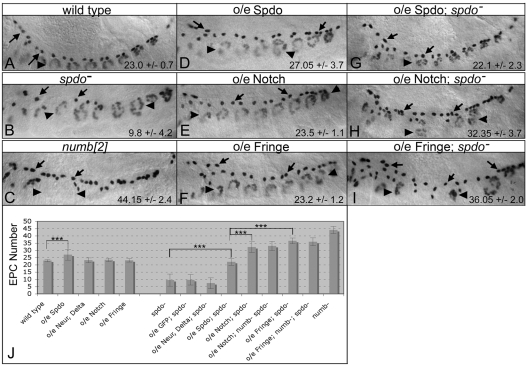Fig. 7.
Overexpression of Notch or Fringe bypasses the requirement for spdo function during EPC development. Each panel shows a lateral view of eve expression in the dorsal mesoderm. (A) Wild-type stage 14 embryo showing EPCs (arrows) and Eve+ DA1 muscles (arrowheads). (B) spdo mutant embryos exhibit a decrease in EPC number (arrows). (C) In numb mutant embryos EPC numbers double (arrows) and Eve+ DA1 muscles are lost (arrowheads). (D) twist-GAL4-mediated overexpression of Spdo (o/e spdo) in the mesoderm of wild-type embryos increased EPC numbers (arrows). (E,F) Identical experiments with either Notch (E) or Fringe (F) had little effect on EPCs (arrows) or DA1 muscles (arrowheads). (G-I) Mesodermal expression of spdo in a spdo mutant embryo rescued the spdo mutant phenotype (compare to B), whereas mesodermal overexpression of Notch (H) or Fringe (I) in spdo mutant embryos increased EPC numbers (arrows) and decreased DA1 muscle numbers (arrowheads), phenotypes similar to those of numb mutant embryos (compare with C). Numbers indicate average number of EPCs ±s.d. per bilateral side of an embryo. n≥20 embryo sides, except for o/e spdo; spdo− (n=14). (J) Chart shows average number of EPCs per indicated genotype.

